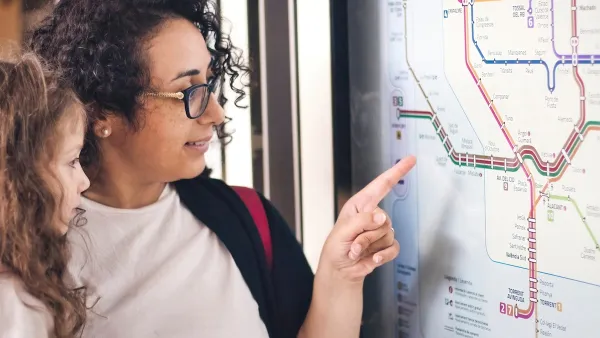The Institute for Transportation and Development Policy helps cities in the developing world address traffic and congestion with creative, cost-efficient solutions. Executive Director Walter Hook shares some strategies for the US as well.
"In developing countries, the people who own and operate cars tend to be a small minority; they tend to be the richest people in country, and they tend to be the decision-makers. In the developing country context, the notion of using scarce public roads and space to give priority to public-transit users, cyclists, pedestrians, open space, and meaningful interaction in the public realm has a class meaning. Dedicating urban public space and roads to private cars means turning over most of those public resources to the richest 10–20 percent."
"Any mayor or district that controls roads is making a choice about whether that public space should be dedicated to subsidized private parking or dedicated to a bike lane and a widened sidewalk with park benches and new trees along it. That is a choice. The width of the road that is dedicated to private cars is a choice. And then, whether to create a bus lane or to leave it a mixed traffic lane: that is a political choice. Whether to build 300 km of bike lanes or ignore cycling as a possibility: that is a political choice. Those are all political choices.
"Public space-how it is used and allocated-is not something that is, at the end of day, determined by abstract engineering principles. It is a choice made every day by politicians, who have, in this country, thought that our public space should be dedicated to moving private motor vehicles around, even if it's at the expense of human interaction. That being said, obviously shopkeepers and other people have some vested interest in parking. The process of reclaiming this public space has to be done in a participatory way where shopkeepers that want their streetscapes full of cars should have that option."
Thanks to Josh Stephens
FULL STORY: ITDP Seeks to Help Third World Cities Avoid Congestion and Auto Dependency of First World

Planetizen Federal Action Tracker
A weekly monitor of how Trump’s orders and actions are impacting planners and planning in America.

San Francisco's School District Spent $105M To Build Affordable Housing for Teachers — And That's Just the Beginning
SFUSD joins a growing list of school districts using their land holdings to address housing affordability challenges faced by their own employees.

Can We Please Give Communities the Design They Deserve?
Often an afterthought, graphic design impacts everything from how we navigate a city to how we feel about it. One designer argues: the people deserve better.

Engineers Gave America's Roads an Almost Failing Grade — Why Aren't We Fixing Them?
With over a trillion dollars spent on roads that are still falling apart, advocates propose a new “fix it first” framework.

The European Cities That Love E-Scooters — And Those That Don’t
Where they're working, where they're banned, and where they're just as annoying the tourists that use them.

Map: Where Senate Republicans Want to Sell Your Public Lands
For public land advocates, the Senate Republicans’ proposal to sell millions of acres of public land in the West is “the biggest fight of their careers.”
Urban Design for Planners 1: Software Tools
This six-course series explores essential urban design concepts using open source software and equips planners with the tools they need to participate fully in the urban design process.
Planning for Universal Design
Learn the tools for implementing Universal Design in planning regulations.
Borough of Carlisle
Smith Gee Studio
City of Camden Redevelopment Agency
City of Astoria
Transportation Research & Education Center (TREC) at Portland State University
City of Camden Redevelopment Agency
Municipality of Princeton (NJ)


























